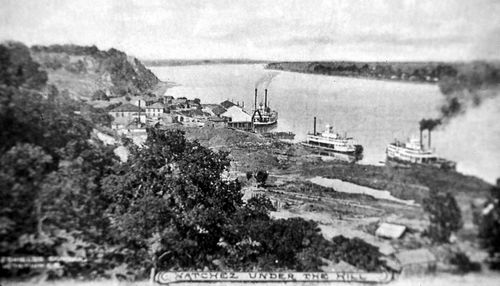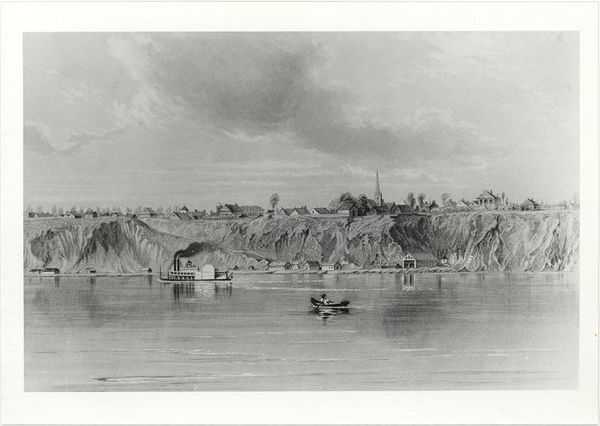Annotation:Natchez Under the Hill (1): Difference between revisions
No edit summary |
No edit summary |
||
| Line 10: | Line 10: | ||
<div style="text-align: justify; direction: ltr; margin-bottom: 90px; margin-left: 70px; margin-right: 120px;"> | <div style="text-align: justify; direction: ltr; margin-bottom: 90px; margin-left: 70px; margin-right: 120px;"> | ||
<br> | <br> | ||
'''NATCHEZ UNDER THE HILL [1].''' AKA and see "[[Turkey In the Staw]]," "[[Old Bog Hole (The)]]," "[[Old Zip Coon]]." Old-Time, Breakdown. USA; Oklahoma, Arkansas, Missouri, Virginia. A Major. AEae tuning (fiddle). AABB (Chase, Thede): AA'BB' (Beisswenger & McCann). "Natchez Under the Hill" is a title attached to a several distinct tunes and their variants, particularly in the Midwest. However, the most popular of the tunes with this title can easily be recognized for it was perhaps progenitor of, the American fiddling standards "[[Turkey in the Straw]]" and "[[Old Zip Coon]]" (it is distinct from the latter, a Northern relative, by virtue of the two different beginning measures). It appears to be American in origin, though Alan Jabbour sees the roots of the tune in the English country dance melody "[[Rose Tree ( | '''NATCHEZ UNDER THE HILL [1].''' AKA and see "[[Turkey In the Staw]]," "[[Old Bog Hole (The)]]," "[[Old Zip Coon]]." Old-Time, Breakdown. USA; Oklahoma, Arkansas, Missouri, Virginia. A Major. AEae tuning (fiddle). AABB (Chase, Thede): AA'BB' (Beisswenger & McCann). "Natchez Under the Hill" is a title attached to a several distinct tunes and their variants, particularly in the Midwest. However, the most popular of the tunes with this title can easily be recognized for it was perhaps progenitor of, the American fiddling standards "[[Turkey in the Straw]]" and "[[Old Zip Coon]]" (it is distinct from the latter, a Northern relative, by virtue of the two different beginning measures). It appears to be American in origin, though Alan Jabbour sees the roots of the tune in the English country dance melody "[[Rose Tree (The)]]," while others note the similarities of the English morris dance tune "[[Old Mother Oxford]]." Jabbour (1971) states: "The only conspicuous difference in the melodic contours is that 'The Rose Tree' drops to tonic in the third phrase of the second strain, while the American tunes thrust up to the octave for rendering much of the same melodic material." Though it seems clear its roots were in the British Isles, "Natchez Under the Hill" appears to have been one of the earliest American tunes that can be characterized as "old-timey" (i.e. having entered American traditional fiddling repertoire via the folk process) and a popular one. It was first published in this country in George P. Knauff's '''Virginia Reels, volume I''' (1839), although Mark Wilson says it was mentioned in print twenty years prior to that. The title was again mentioned in a humorous dialect story called "The Knob Dance," published in 1845, set in Eastern Tennessee. Brown maintains the tune served as a "rhythmically enlivened" transitional melody between "The Rose Tree" and the song "Old Zip Coon" (curiously published in 1834, five years before the Knauff's printing of 'Natchez'--the two tunes were probably older than their publications), which closely follows "Natchez" harmonically and melodically (save the opening arpeggios of "Natchez" are replaced by a more sing-able phrase). By at least 1899 it was enough of a "chestnut" that it had become a category tune for fiddlers' contests, like the one held that year in Gallatin, Tennessee. Each fiddler would play his version, and the rendition judged the best won a prize (C. Wolfe, '''The Devil's Box''', vol. 14, No. 4, 12/1/80). | ||
[[File:natchez1.jpg|500px|thumb|left|Natchez-Under-the-Hill]] | [[File:natchez1.jpg|500px|thumb|left|Natchez-Under-the-Hill]] | ||
<br> | <br> | ||
Revision as of 19:24, 13 February 2019
X:1 T:Natchez on the Hill [1] M:2/4 L:1/8 R:Reel B:George P. Knauff - Virginia Reels N:Published in Baltimore by Geo. Willig n.d. (1839) Z:AK/Fiddler's Companion K:A A/E/c/A/ E/C/A/E/ | C/A,/E/C/ A,A/B/ | [Ec][Ec] (c/B/A/B/) | [Ac][EGB] [EGB]E | {E}Ac/A/ EA/E/ | CE/C/ A,e | a/g/a/e/ f/e/c | e/c/B/c/ Az || c/e/e/f/ e/c/B/A/ | c/e/e/f/ ee | {g}f/e/f/g/ a/g/f/e/ | e/f/f/g/ fg | [c2a2] e/a/c | [Ac]B/A/ BA/B/ | [Ac][Ac] c/B/A/F/ | E/A/A/B/ A z ||
NATCHEZ UNDER THE HILL [1]. AKA and see "Turkey In the Staw," "Old Bog Hole (The)," "Old Zip Coon." Old-Time, Breakdown. USA; Oklahoma, Arkansas, Missouri, Virginia. A Major. AEae tuning (fiddle). AABB (Chase, Thede): AA'BB' (Beisswenger & McCann). "Natchez Under the Hill" is a title attached to a several distinct tunes and their variants, particularly in the Midwest. However, the most popular of the tunes with this title can easily be recognized for it was perhaps progenitor of, the American fiddling standards "Turkey in the Straw" and "Old Zip Coon" (it is distinct from the latter, a Northern relative, by virtue of the two different beginning measures). It appears to be American in origin, though Alan Jabbour sees the roots of the tune in the English country dance melody "Rose Tree (The)," while others note the similarities of the English morris dance tune "Old Mother Oxford." Jabbour (1971) states: "The only conspicuous difference in the melodic contours is that 'The Rose Tree' drops to tonic in the third phrase of the second strain, while the American tunes thrust up to the octave for rendering much of the same melodic material." Though it seems clear its roots were in the British Isles, "Natchez Under the Hill" appears to have been one of the earliest American tunes that can be characterized as "old-timey" (i.e. having entered American traditional fiddling repertoire via the folk process) and a popular one. It was first published in this country in George P. Knauff's Virginia Reels, volume I (1839), although Mark Wilson says it was mentioned in print twenty years prior to that. The title was again mentioned in a humorous dialect story called "The Knob Dance," published in 1845, set in Eastern Tennessee. Brown maintains the tune served as a "rhythmically enlivened" transitional melody between "The Rose Tree" and the song "Old Zip Coon" (curiously published in 1834, five years before the Knauff's printing of 'Natchez'--the two tunes were probably older than their publications), which closely follows "Natchez" harmonically and melodically (save the opening arpeggios of "Natchez" are replaced by a more sing-able phrase). By at least 1899 it was enough of a "chestnut" that it had become a category tune for fiddlers' contests, like the one held that year in Gallatin, Tennessee. Each fiddler would play his version, and the rendition judged the best won a prize (C. Wolfe, The Devil's Box, vol. 14, No. 4, 12/1/80).

Marion Thede (1967), quoting Cushman, elucidates the title, the name of a river town in the state of Mississippi:
'Natchez Under the Hill' was in that early day (the late 1700's and early 1800's) the sine qua non as the point of rendezvous for the rough and care-for-nothing men who navigated the keel and flat boats on the Mississippi River ere they were superseded by the steamboat. At that early day the city of Natchez was an excellent market for the products of the 'upper country', consequently hundreds of heavily laden and richly-laden boats congregated there, to the great dread of the law-abiding and peaceful inhabitants residing in the upper part of the city, known as 'The Bluff;' for the wild and lawless boatmen knowing no restraint...indulged in their caprices in every kind of rowdyism known to man...thus did those specimens of American freemen spend their leisure hours in drinking whiskey, yelling, fiddling, dancing, and fist-fighting...'

Sandy Hook, Kentucky, fiddler Alva Greene called his version "Matches Under the Hill," but had no explanation for the title. Kerry Blech suggests comparison with the Cape Breton/Scottish tune "Old Bog Hole" which seems to be a close relative or variant of "Natchez." A version of "Bog Hole" was fiddled by Joe MacLean on Rounder 7024, "Old Time Fiddle Music from Cape Breton Island."
"Natchez" was recorded in 1941 for the Library of Congress by musicologist/folklorist Vance Randolph from Ozarks Mountains fiddler Lon Jordan, of Farmington, Arkansas (AFS 5317 A3), and was reissued on the Library of Congress LP AFS L62, "American Fiddle Tunes from the Library of Congress," edited by Alan Jabbour. In introducing the tune, Mr. Jordan says before playing: "'Natchez Under the Hill'-it sounds a lot like 'Turkey in the Straw', but there's a difference!" Other Library of Congress recordings of the tune were made in 1937 of Theophilus G. Hoskins of Hyden, Kentucky (AFS 1520 A1), and in 1941 of Emmett Lundy of Galax, Virginia (AFS 4941 A3). See also the Texas variant "Why Can't a White Man Dance Like a N.... Can?" from the playing of Orville Burns and Ace Sewell.
